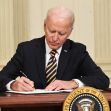President Biden unveiled his sweeping new infrastructure plan for America on Wednesday. The daring proposal includes plans to fix 10,000 bridges, about 20,000 miles of roadways, and more.
The new $2 trillion plan includes new corporate tax hikes, robust climate change laws, millions of new jobs and training for Americans, and enhanced racial inequity legislation, among other initiatives.
During a stop on his national road trip across the US, President Biden described the transformative Infrastructure Bill, saying, "It is a once-in-a-generation investment in America."
With its far-reaching American plans and spending to refurbish crumbling infrastructure, including roadways and bridges, and create generational new American jobs, Biden's plan is similar to President Franklin Roosevelt's Works Progress Administration (WPA).
The WPA, launched in 1935 at the end of the global Depression, also invested gigantic funds into infrastructure, American jobs, and cultural projects.
Both plans also called for very ambitious federal funding. Compared to Biden's $2 trillion budget, the WPA's 1935 $92 billion cost, adjusted for inflation, is now equal to $1,788,328,955,224.
Biden's new infrastructure bill, like the WPA, addresses a severe national crisis in America. In 1935, the overarching issue was the Depression, and in 2021, Americans are facing the grim results of the Pandemic.
Both presidents offered robust, dramatic plans to regenerate the economy, put people back to work, fix crumbling infrastructure and address American citizens' multi-cultures at the same time.
Like the WPA, Biden's new plans include new work in construction, pipe repair, bridgework, climate change, new schools, and the creation of millions of paying jobs.
Also in comparison to the WPA, Biden's plan includes more jobs for millions of Americans. Biden's proposal provides funds to train many millions of workers and include new in-home care for senior citizens and disabled residents. Simultaneously, workers who care for seniors and disabled Americans will get a pay hike.
Biden's Infrastructure Bill will activate in two phases.
First up is the ambitious overhaul of the entire US economy, which Biden calls the "American Jobs Plan." As part of this plan, including the infrastructure improvements for roadways and tunnels, lead pipes throughout the country will be removed and replaced to address the dangerous health issue of children drinking from lead pipes.
The second phase, known as the "American Family Plan," will include increasing taxes on wealthy people and large corporations.
Both Biden's new Infrastructure plans and Roosevelt's multi-layered New Deal and WPA bills were fashioned out of the common need for a tired nation beaten down by dire times.
In both 1935 and today, these visionary bills tackle economic Depression, so Americans can rise again.
In 2021, Biden's multi-layered plan addresses the bitter outcomes of a global pandemic, with the goal of improving American roads and bridges and the birth of new modern technology-led jobs available for all citizens.
Most Republicans are not in favor of Biden’s sweeping new bill. In 1935, President Roosevelt also faced many critics with the launch of the WPA.
Faced with harsh criticism by political opponents, President Roosevelt said, “It is hard to fail, but it is worse never to have tried to succeed.”






